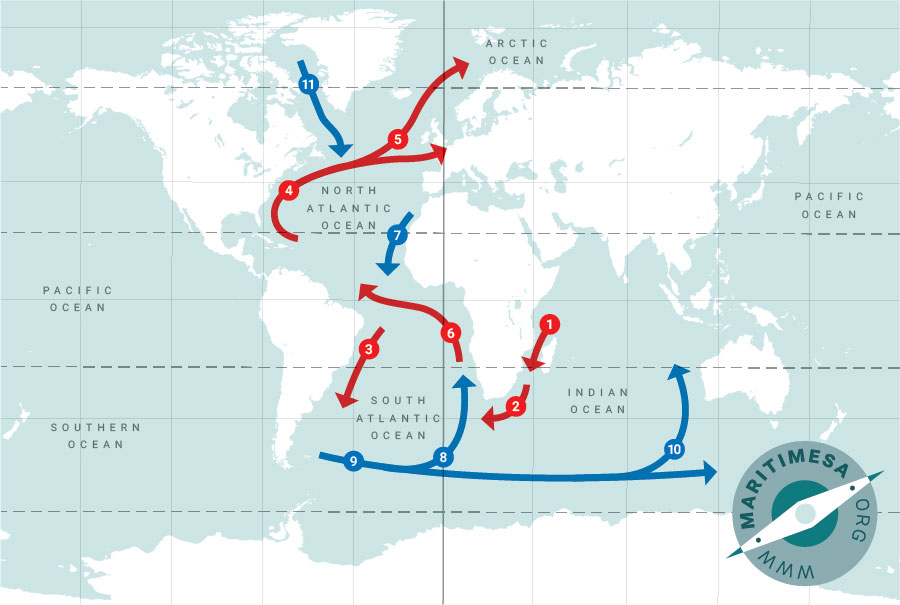[vc_row][vc_column][vc_video link=”https://vimeo.com/522681618″][vc_column_text]Types of current. Unlike tidal currents, ocean currents are not dependent on gravitational effect produced by the interaction of sun and moon. They are caused by the differences in level, or in salinity/density, or in temperature between various masses of water, in which case they are called stream currents, or by the wind blowing continuously over the surface in the same direction, in which case they are called drift currents. Stream currents may attain a rate of three to five knots, eg the Gulf Stream, Kuro Siwo, the surface currents through the straits of Gibraltar into the Mediterranean Sea, and locally the Agulhas current. Drift currents may attain one or two knots, the principal ones being the southern Ocean or Great west Drift and the Trade Drifts, an off-shoot of which is the Benguela current which flows up the west coast of the RSA.
Effect on shipping. The effect of currents on shipping is two fold, ie they can directly affect the course and speed at which the ships proceed and it can also affect the weather in the region. How do they do this? Let us take the currents which flow along our own coast, ie the Agulhas current.
Agulhas current. The Agulhas current has its origins in the South Equatorial current which flows westwards until it reaches Madagascar and the east African coast. Here it turns southward and at first is called the Mozambique current. When it reaches the coast of South Africa in the vicinity of 26° south latitude, it is called the Agulhas current. Because of its origin in equatorial waters, the water is warm and as a consequence it warms the air immediately above it. Besides raising the temperature of the air, it also raises the dew point and hence the water carrying capacity of the air. This water vapour enriched air expands because of the increase in temperature, becomes lighter and rises. With the consequent cooling of the air as it rises, clouds are formed. Precipitation in the form of rain is also likely as are fresh to strong winds at times.
Benguela current. In the case of the Benguela current, it has its origins in the relatively cold Southeast Trade Drift which flows eastwards from the Brazilian coast until it reaches the coast of South Africa. Here it turns northwards and becomes the Benguela current. Because of the relatively cold temperature of the water, the air immediately above it becomes cooled until it reaches saturation point and results in the formation of fog off the west coast of South Africa and Namibia. At the same time this cooling effect encourages the formation of high pressure systems, with clear skies and very little rain. These are well known characteristics of the west coast.
The state of the weather in ports can also have an adverse effect on the loading and discharging of cargo, ie unpackaged or bulk cargoes such as sugar, grains, certain ores, etc would be ruined if they became damp as a result of rain.
The following diagram shows the principal currents of the world:

- Mozambique
- Aghulas
- Brazil
- Gulf Stream
- North Atlantic
- South Equatorial
- Canary
- Benguela
- Southern Ocean or West Wind Drift
- South East Trade
- Davis

